Rebuilding with color
Driving into New Orleans for the first time was quite somber. I had been traveling along I-10 when it suddenly turned into a 12-mile long bridge over open water, Lake Ponchartrain. The thought of running off bridges into water has always scared me, so I tried closing my eyes. It was hard not to steal glances and stare out the window, however. I was completely surrounded by rocky waters, with no clear sight of land. Temporary bridge sections had been erected along the stretch of floating road, which made my stomach turn even more. How did people ever escape this water? How could something that can look and sound so peaceful be such a beast?
When we finally reached dry land, I opened my eyes and breathed a sigh of relief, only to be taken aback by what I was now staring at: total devastation. New Orleans East was almost completely destroyed and it looked as if only ghosts lived there. I didn’t say a word—just took it all in as my parents and I continued to drive along the bumpy highway. I wondered what my new house would look like. I knew it was in good shape now, but what had it looked like right after the storm? I also knew that a big part of my new neighborhood had avoided flooding and it only suffered from wind and rain damage. But, what was it going to look like now? Would the bright, blue tarps acting like roofs be as abundant around my house as they were out here? This place was a mess—like a bomb had gone off; it was almost like pictures you see from war zones, but I was really witnessing it. Houses with missing walls (so you could see its’ insides that had been completely gutted out), entire roofs blown away, trees down, brick fences completely knocked over, and as expected, a trailer in many of the yards.
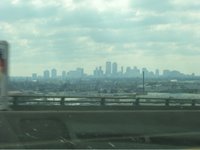
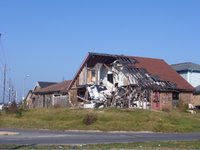

We got off the interstate and drove down Elysian Fields Road toward the river. Almost there. We were stopped by a light right in front of a hot pink building that was covered in big, yellow signs that read “24 hours” and “Free Drink with Every Po-Boy.” Wow. I don’t think that I had ever seen a hot pink building before in my life. It called to me.
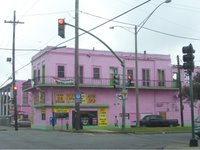
The light changed and we found our way onto St. Claude Avenue toward Independence Street. Some of the buildings we passed were completely empty, ready to be bull-dozed over, while others were freshly painted with bright colors, colors most people would never imagine putting on the outside of a house. I smiled. I like bright colors and it made me feel that all was not lost. I think the houses were smiling, too, thankful to have survived and once again be a home for spirited people.
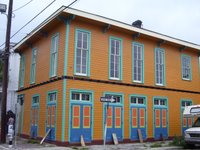

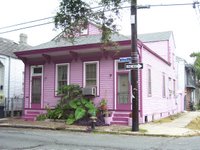
The more I’ve explored my neighborhood since then, the more houses I have passed by that are wrapped in vibrant, flamboyant color combinations. This neighborhood is called Bywater—one that is full of diversity and character, in both houses and people. Everyday, I see a house and think, “oh, I love that color! That’s what I would use on my home!” I wish I had my own home to paint. Right now, my dream house would have been repainted about 25 times. When I was a little girl I always wanted to paint my bedroom walls and ceiling so many different colors that would all fade into each other. It was never allowed and I was stuck with boring, white walls.
I often wonder why some people choose to paint their houses in plain, dull colors, while their neighbor might produce such wonderful eye candy. Back in Lexington, there is a small row of houses on Oldham Avenue that breaks out of the plain-house rhythm. Every strip of trim is a different color and I love walking down that street to see them.


The influx of Mediterranean and Caribbean cultures is what influences the people to paint houses multiple colors. Creoles have been painting their houses like this since the turn of the 20th century, the Victorian Period here in New Orleans. During the 1950’s, however, most residents began painting their homes white with green shutters, because of the low-cost. Then, in the 1970’s, a new group of people moved into the neighborhood that were artists and part of the H.I.P.P.I.E. culture, and made the houses sparkle again with different colors. The area has taken on a bohemian attitude and attracts people who like to remodel houses. Since Bywater was listed on the National Historic Preservation list in 1993, the neighborhood has celebrated their local architecture by painting more and more of them in bright colors.
Since Katrina, however, many of these colorful homes have been left with physical reminders of what went wrong here. X’s and water lines form a layer on almost every building and home in the city. Bywater was barely touched by the flood, but as you drive through the rest of the city you can see the water lines gradually rise and fall, letting you know the depth of the flood. How people have responded to them makes me sit and ponder. I’ve noticed that some have completely put new layers of fresh paint to begin again, celebrating their survival and showing the world that everything is okay. Some people have only covered up the X itself with paint, letting you see that it is still there, only now disguised. The rest have left their houses as is, as if to let everyone know, everyday that this city is not okay and must not be forgotten.

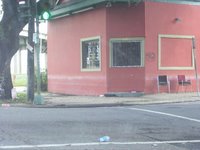

New Orleanians are working hard all day, everyday, trying to bring back what they once had; but they also celebrate the memory of their city and their survival and show that the true New Orleans is not lost. The physical appearance of the city was damaged, but its heart and playfulness is alive and well, more apparent day by day, through singing and dancing and lots of color.
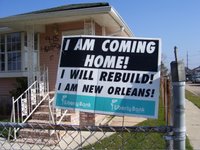

-k. McOwen

0 Comments:
Post a Comment
<< Home